This was published 5 years ago
'It took a lot of guts': Tracey Moffatt's eerie new portals
By Chloe Wolifson
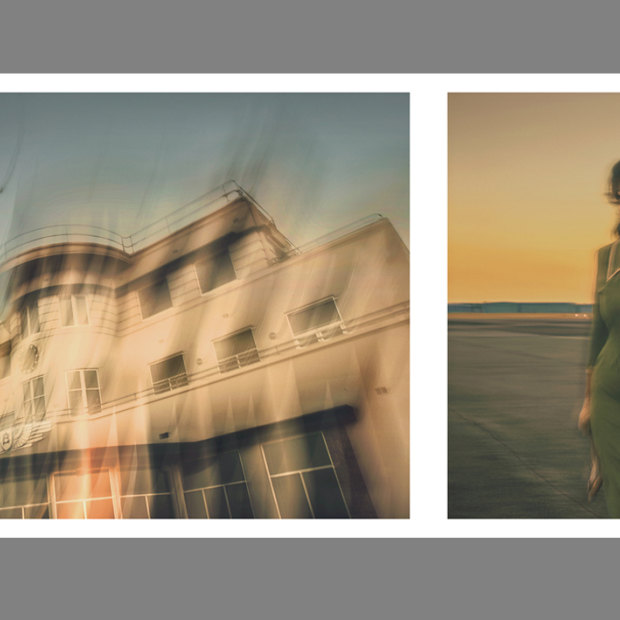
The Airport (2019) by Tracey Moffatt, diptych, large C-type print.Credit: Courtesy of the artist and Roslyn Oxley9 Gallery
Tracey Moffatt is in the stockroom of Roslyn Oxley9 Gallery, examining six photographic diptychs that comprise the upcoming show Portals, her first Australian presentation since representing the country in the 2017 Venice Biennale.
"The Hospital Ship particularly needs to be spot-lit, to make it more eerie."
She first saw these new works framed and hung together the day before. While she wasn't sure she'd have the right words for them then, today finds her feeling more comfortable.
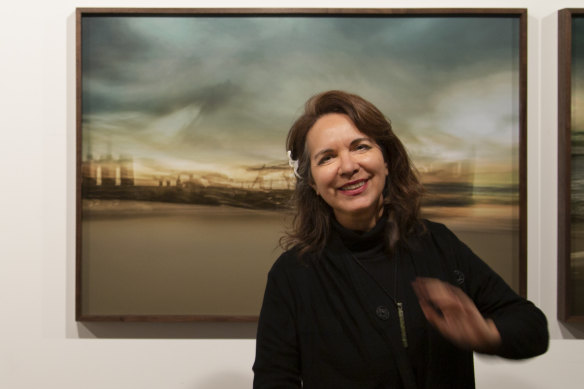
Tracey Moffatt in the storeroom of the Roslyn Oxley9 Gallery for a test hang of Portals.Credit: Luis Power
Since first exhibiting her photographs and films in the mid-1980s, Brisbane-born Moffatt has crafted visual stories which draw viewers into the work with suggestions of narrative, while leaving space for individual imagination. She is a voracious consumer of culture, from Hollywood to Romantic painting to music documentaries, these influences subtly coalescing in the atmospheres of her works.
Each of Moffatt's photo-series over the past three decades has its own distinct look and feel due to the artist's ongoing experiments with shooting and printing techniques.
Likewise, Portals began with a reinvention of the photographic form in the pursuit of an idea. The ghostly imagery in the works is the result of Moffatt throwing out the rule book and shooting in low light, early or late in the day with a slow shutter speed.
"[It] took a lot of guts, as an artist working with the photographic image, to present a strobing [effect]," she says. The initial result of the experiment was "a terrible dark blob," Moffatt recalls. "The images had to be pulled out of the darkness. To begin with, I pulled them out too much; they were overly bright, [so] I went back to … a sort of murk. But I don't want to present murk, I have a love of painting and colouration. The colouration had to be almost like old Kodachrome or faded back slide."
I point out a sliver of mauve along the roofline of the house in The Departure/Arrival. It sings quietly but intensely among peach and mint tones. Moffatt describes the rigorous test-printing process leading to that point, estimating each work is the result of fifty large trial prints. A few weeks before the exhibition, she was at the framers "snatching away" photographs for reprinting. "There's no full stop. You've got to just leave it alone."
Other than Moffatt herself, the only other person to appear in Portals is a little girl running through sun-streaked bushland in The Visit. The red pattern on her dress echoes that worn by the artist in the accompanying image, which in turn recalls Moffatt's character in her iconic 1989 series Something More, in which a young woman wearing a red cheongsam attempts to leave her rural home for the city, with tragic consequences.
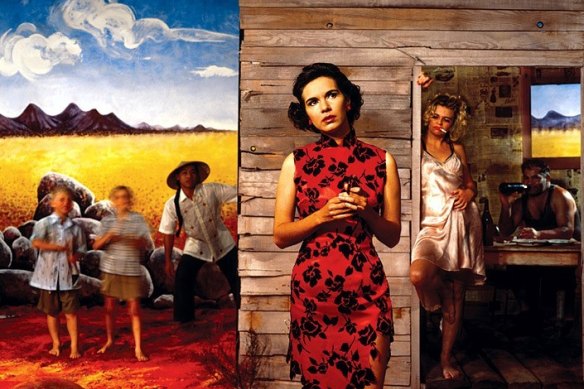
The iconic image from 1989's Something More.Credit: Tracey Moffatt
Something More was Moffatt's first solo exhibition, shown at the Australian Centre for Photography in 1989. The following year her short film Night Cries: A Rural Tragedy featuring Marcia Langton was selected for official competition at Cannes. Exploring the relationship between an Aboriginal woman and her white adoptive mother, the film echoed elements of Moffatt's personal history.
A keen consumer of pop culture throughout childhood, Moffatt regularly corralled young relatives into acting in low-budget, TV-inspired tableaux. While her later studies at the Queensland College of the Arts exposed her to broader influences, those early passions remain. When making Portals Moffatt had in mind the cinematic technique "day for night", where sequences in 1940s and 50s Technicolor cowboy films shot in daytime were darkened "so it looked like night but you could see into it, like a campfire scene or an outlaw escaping on a horse. I remember as a kid I always knew it was fake."
Portals contains its own Outlaw. Moffatt plays this and the other characters in each 'short fiction'. The more visual slippage the image contains, the more Moffatt dissolves into the characters. The smoking figure in The Outlaw, hat angled over eyes, is confidently androgynous; the woman in The Bunker leaves a shadow-like stain in her wake; the nurse in The Hospital Ship is translucent, emerging from the waves barefoot while a white glow illuminates the crosses on her head and heart.
The works were shot in remote locations which Moffatt doesn't wish to reveal, preferring to leave possibilities open for the viewer. The stories are based on true events from those sites.
"That wreck was a hospital ship that went down in a cyclone in the 1930s [and] also relates to a tragic story about the hospital ship Centaur, bombed during WWII in Moreton Bay, the region of Queensland I come from." Despite being clearly marked with a Red Cross, the Centaur was torpedoed in 1943 resulting in the death of more than 200 people.
It's important for young artists to hear about the anxiety, that I'm not cocksure. I'm not insecure either...
Tracey Moffatt
"I took clear shots of that rusted wreck, and it had no mystery in it. The files I discarded … had no story, it was nothing but a lump sitting on a beach and I wasn't interested to see the detail of the barnacles. It had to be fragmented, [to allow] the audience to connect it together." The result, when paired with the apparition of the nurse, is mirage-like.
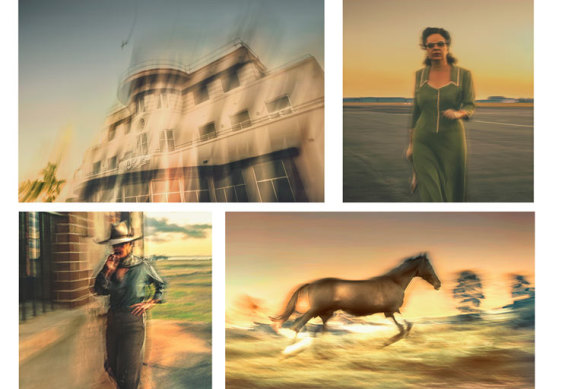
The Airport, top, and The Outlaw, Tracey Moffatt, 2019, diptychs from the series Portals, c-type print.Credit: Courtesy of the artist and Roslyn Oxley9 Gallery
While the six diptychs in Portals are connected through composition, colour and atmosphere, each tells a story with its own space and time. Moffatt points out the structure in The Departure/Arrival. "That's a French colonial building. For me, it's like something out of Gauguin's Tahiti. I read artist biographies big-time and I loved the one on Gauguin and his carry-on with French authorities on the island. The palm trees [suggest] somewhere exotic. It's the Governor's house. I love Pacific and colonial architecture, which I grew up with."
Moffatt's work has taken her worldwide. Feature film Bedevil was shown at Cannes in 1993. In 1997 prestigious Dia Art Foundation commissioned the work Heaven, and the solo exhibition Free Falling at Dia introduced Moffatt to the US. That same year she moved to New York, where she lived until 2010.
"I knew there would be a huge audience [for the work]. But the key thing was my love of the city. I went out every night, for ten years. I didn't want to miss a thing. You honestly can't take your eyes off it. I think if you're a visual artist and you're not making the pilgrimage to New York, it's like being an actress and ...pretending that Hollywood doesn't exist."
My self was all I could deal with
Tracey Moffatt on life after the Venice Bienale
Moffatt's proposal was selected by a panel of judges to represent Australia at the 2017 Venice Biennale (making Moffatt the first Aboriginal artist to present a solo exhibition at this pinnacle of global art events). Her exhibition My Horizon (some works are currently showing at the Mosman Art Gallery) included photography and video incorporating themes from colonial dispossession to the plight of refugees. Despite being one of Australia's most internationally recognised artists, shown and collected by major institutions from the Pompidou to the Tate to the Guggenheim, Moffatt felt the weight of responsibility.
"I had to forget about it and [not] lose sight of the big picture." She is full of praise for the Australia Council.
Moffatt becomes emotional recalling the opening as "one of the greatest days of my life. You know when you have a dream [where] everyone in your life's around you? That's what it was like. Everyone you adore, turns up … It was like a dream come true. And I didn't care about my work, it was up and I didn't care what anyone said."
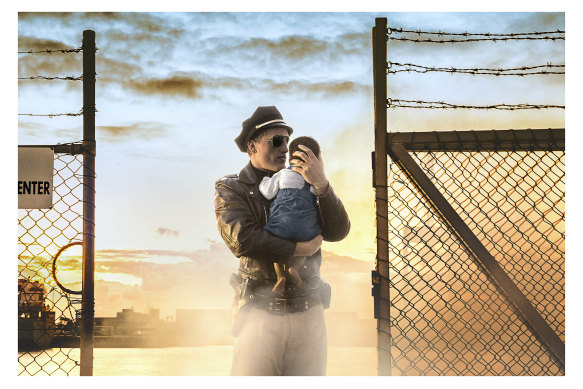
An image from the Venice Biennale show, Passage from My Horizon.Credit: Tracey Moffatt
"To think four days before that opening I was freaking out about the install. I don't think many people know what goes on with artists who have high profiles, the attention can get to you. It's important for young artists to hear about the anxiety, that I'm not cocksure. I'm not insecure either, but you have to humble yourself to the experience of making art. It doesn't come from confidence, it comes from questioning and finding your way with it."
A month after that excitement, Moffatt found herself alone in a motel somewhere, looking for locations that would become Portals.
"This [show] might have been a Venice recovery, it was brewing [beforehand] and I started it as soon as I got home. Maybe that's why I didn't work with other people [at that point], because my self [was] all I could deal with [after Venice]."
Her career has taken her all over the world, and for now Moffatt is back in Australia. There are practical advantages, such as the quick drive to Bunnings (versus the "rigmarole" of hiring vans and carrying work up six flights of stairs to a New York studio), and less practical considerations.
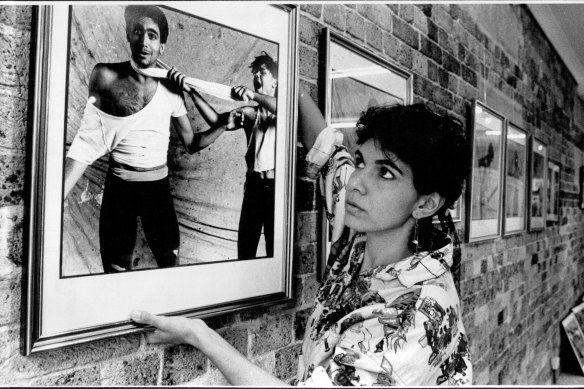
The young photographer in 1987.Credit: Fairfax Media
"I love this part of the world. I rent an ordinary apartment that overlooks a spectacular view of Sydney Harbour, at McMahons Point. I face a nature reserve. It's stunning."
While Moffatt has occasionally had access to studios, she currently lives and works in the same space.
"In a sense I'm still working off the kitchen table. You know, as a kid we did our homework on the kitchen table? Almost nothing has changed."
For the past 12 months she has lived surrounded by the test prints for Portals. "Now I can put my apartment back to normal, hang my art collection."
From childhood backyard tableaux to motel-based location scouting, Moffatt seems hardwired to be an artist.
"My imagination never stops. I can't shut it down. I spend hours at night after working on artworks, placating myself by watching trash television. I'm taking none of it in, but it just calms me."
Interview over, it turns out we are headed in the same direction and Moffatt offers me a lift. Driving along Oxford Street she keenly observes everything: new restaurants, a woman in a striking fur coat, what's playing at the cinema. Passing the Beauchamp Hotel, Moffatt launches into a story about its namesake, an early Governor of NSW who inspired a character in Evelyn Waugh's novel Brideshead Revisited, and reflects on the various merits of its television and film adaptations. While it's clear her imagination works in overdrive, Moffatt distils these imaginings into evocative, extraordinary images.
Portals will be at the Roslyn Oxley9 Gallery from July 11 - August 3.